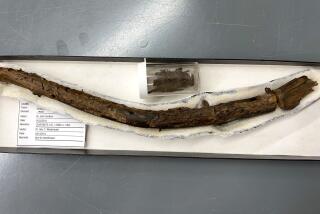What’s Up When Winter Freezes the Growth Rate
After this week of weather, there is little doubt that winter has arrived, and with an uncharacteristic vengeance. The Back East-like cold brought all growing to a stop. Even the rye grass sown on top of Bermuda grass lawns, which is supposed to grow in cool weather, thought it a little too cool and barely needed mowing by week’s end.
Plants now look dormant or nearly so, and to complete this picture of winter in Southern California, the winds stripped the leaves off many trees, including such deciduous fruit trees as peach and plum. For frosting on the cake, some of us even got a little snow.
Gardening doesn’t stop in winter, but it definitely changes, and adjustments are in order. There is no longer the rush to plant, as there was during the fall. Little is growing now--and not much will, until mid-February at the earliest. By all means, go ahead and plant any flowers or vegetables, trees or shrubs, that you intended to plant in the fall but didn’t quite get to, but don’t expect much from them. Even if the days warm up, the soil is now too cold for growth.
It is fortunate that there is so little to do in the garden right now, because you will find precious little time for gardening--the days are so short, the sun so low on the horizon. In the morning it is too darn cold and wet to do much gardening, and it’s dark again by 5 p.m.
One thing you must find the time for in the next two weeks is the planting of those tulips that have been sitting in the refrigerator. Remember to plant them deep, with as much as eight inches of soil covering the bulbs.
The Bare-Root Plants
The other winter planting opportunities are those plants sold bare root, but these will not show up at nurseries until after Christmas.
Plants sold bare root are literally that--they have no soil around their roots. They are usually a bargain compared to plants sold in nursery containers, and many are difficult to find at other times of the year, so bare-root planting is an opportunity not to be missed. The best selection of deciduous fruit trees, such as apples, apricots, peaches and plums; of grapes, blackberries and raspberries, and of roses will be found bare root. Because this bare-root planting season only lasts from after Christmas until mid-February, it is wise to begin planning now for their arrival.
Spraying Fruit Trees
Another winter job is the spraying of deciduous fruit trees while they are leafless. Peaches, in particular, must be sprayed to control peach-leaf curl and if your trees lost their leaves in this last storm, this weekend is the perfect time for the first of two sprayings. Use a lime sulfur spray available at nurseries and follow directions. Spray once now, again in January.
Or you can also use a spray that combines oil and lime sulfur or fixed copper, which will also control overwintering insects (including the hard-to-kill scale insects) that might be clinging to the bark or branches. This oil spray should be used on all deciduous fruit trees while they are leafless.
If your trees grow above other plants, be sure to wash the oil spray off those plants with a strong blast of the hose after you have sprayed the trees above or it may burn their foliage.
Pruning is the other big winter task--of fruit trees and roses--but this is best put off until January or even early February, unless you have a lot to do--in that case, start now.
Perennials that have gone dormant can be cut back now, but you may want to wait a little longer. They will not begin growing again until late February or March and the dried seed heads and browning leaves are decorative in their own way and preferable, in my mind, to bare soil.
Those seed heads are also of great interest to birds--another reason to leave them on the plants. In my garden, I have been watching a hummingbird pluck the downy seeds from Japanese anemones, presumably to make a nest somewhere a little more snug.
Water, But With Care
Though it seems silly to talk about watering after all this rain, watering is part of winter gardening in Southern California, but don’t be too quick about it. It is surprising how long the soil stays wet after a good soaking rain. Because the sun is so low and the plants are dormant or nearly so, it takes as long as two to three weeks for the soil to dry.
Don’t be fooled by Santa Ana winds like we had last weekend--they only dry the surface of the soil. When it really howls, plants may look wilted but it’s only because they haven’t been able to replace the water as fast as the wind steals it away. They’ll perk up the next day.
The only way to know for sure when to water is to test the soil by plunging in a spade or tool made for the job. And don’t think you can’t overwater in winter. Two years ago I drowned two young trees by worrying too much about whether they had enough water.
The exceptions are plants in containers that are very susceptible to drying Santa Anas, and new plants which as yet don’t have roots deep in the soil. These will need to be watered more often. In fact, I have observed the opposite effect in containers--the soil appears to be wet in winter but is dry just below the surface.






